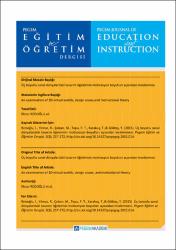An examination of 3D virtual worlds, design issues, and motivational theory

View/
Access
info:eu-repo/semantics/openAccessDate
2015Author
Reisoğlu, İlknurYılmaz, Rabia Meryem
Çoban, Murat
Topu, Fatma Burcu
Topu, Fatma Burcu
Karakuş, Türkan
Göktaş, Yüksel
Metadata
Show full item recordCitation
Reisoğlu, I., Yılmaz, R., Çoban, M., Topu, F. B., Karakuş, T., & Göktaş, Y. (2015). An examination of 3D virtual worlds, design issues, and motivational theory. Pegem Journal of Education and Instruction, 5(3), 257–272. https://doi.org/10.14527/pegegog.2015.014Abstract
The purpose of this study is to assess the motivational qualities of specific design elements in a three-dimensional (3D) virtual winter sports learning environment comprised of an Information House, Practice Area, and Exercise Area by considering two motivational models. the study employed causal comparative research methods. Participants included 150 fifth, sixth, and seventh grade middle school students. A motivation survey developed by the researchers served as the data collection tool; data were analyzed with descriptive and predictive methods. Data analysis revealed that the animations in the Practice Area of the 3D virtual environment drew the most attention when compared to the other design elements. Elements in the Exercise Area encouraged students to conduct more research, and elements in the Information House were efficient at increasing students' satisfaction. in addition, design elements such as animations, images, display boards, and videos helped students to learn individually and provided opportunities to practice within a 3D virtual environment.

















